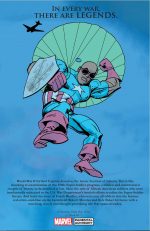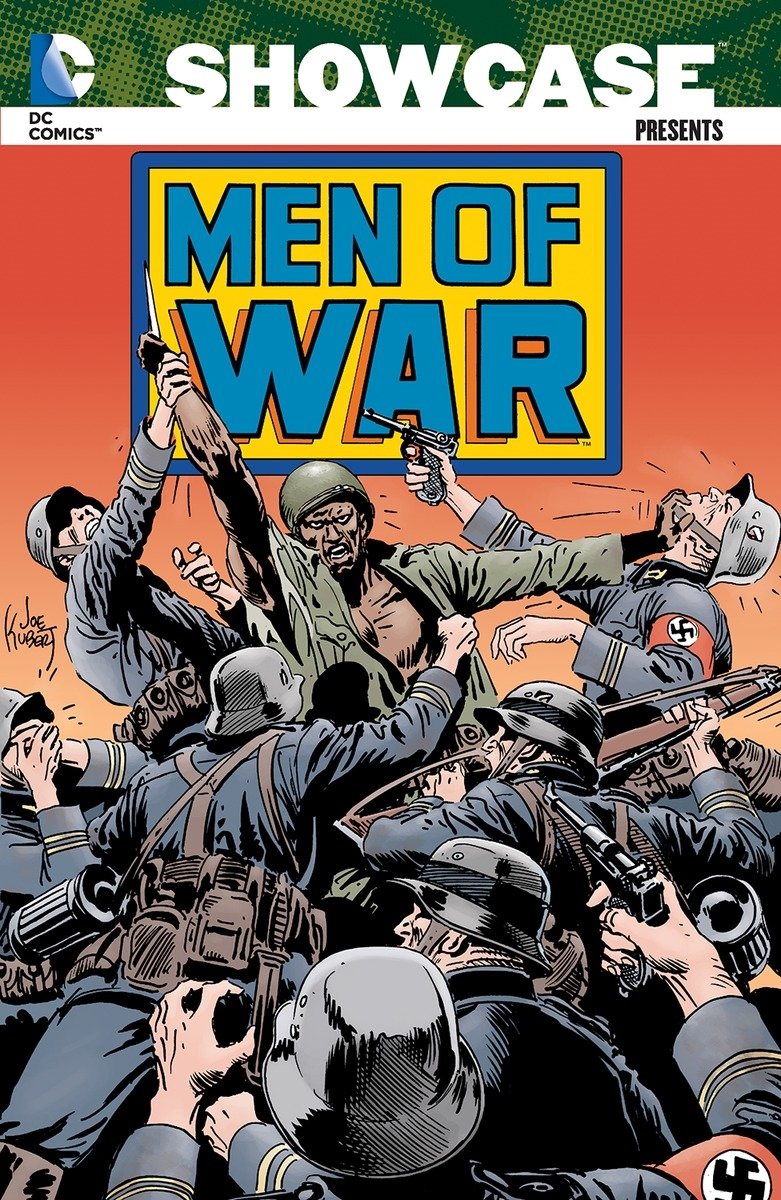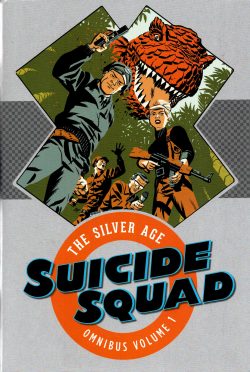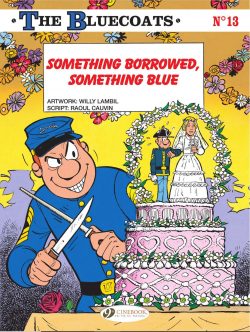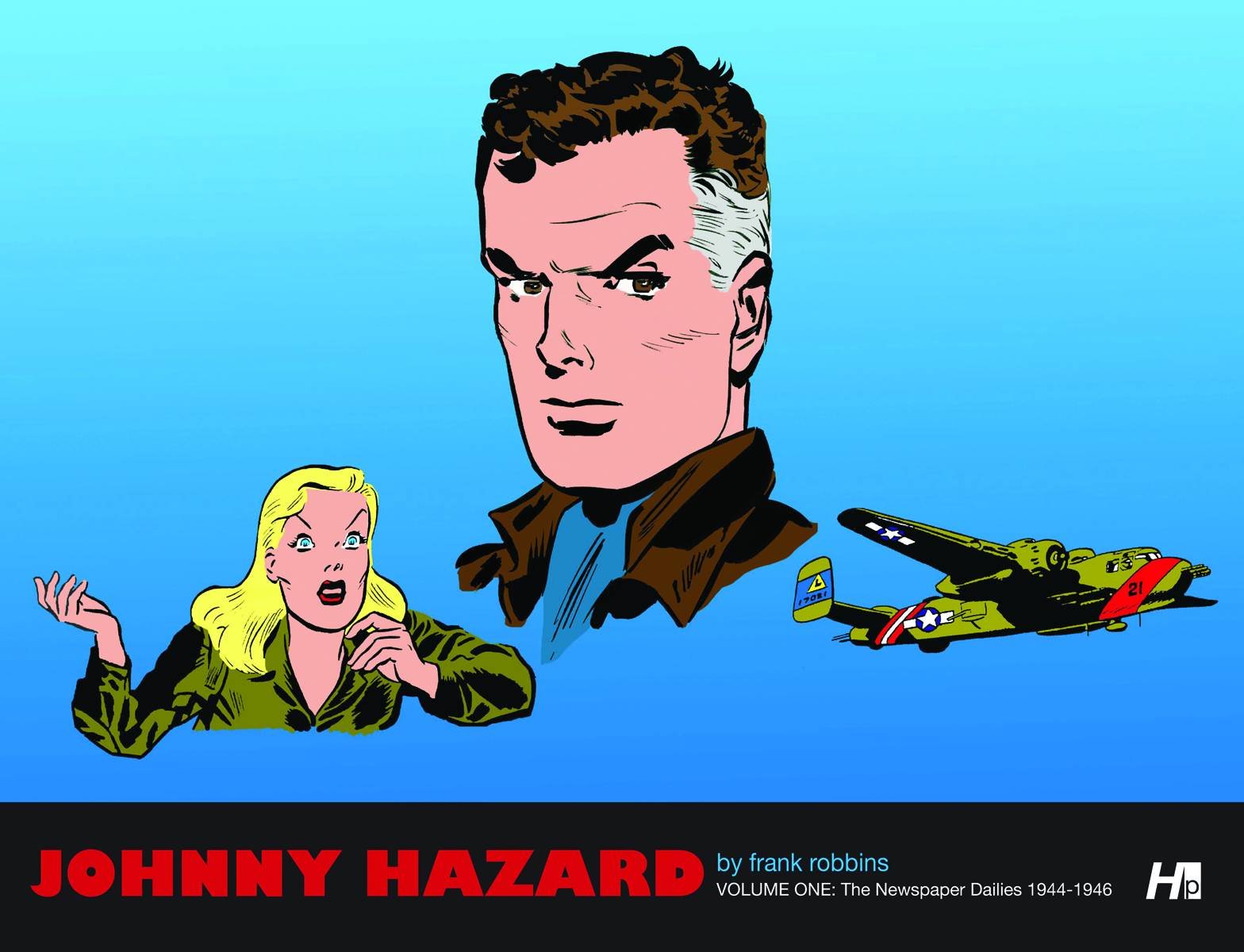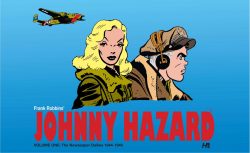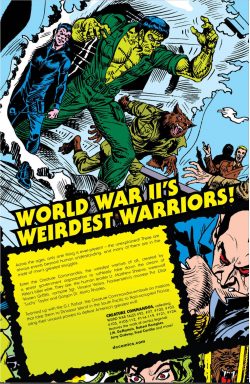

By J.M. DeMatteis, Robert Kanigher, Mike W. Barr, Fred Carrillo, Pat Broderick, John Celardo, Bob Hall, Jerry Ordway, Dan Spiegle, & various (DC Comics)
ISBN: 978-1-4012-4382-1 (TPB/Digital edition)
American comic books just idled along rather meekly until the 1938 invention of Superman provided a flamboyant new genre for heroes: subsequently and bombastically unleashing a torrent of creative imitation for a suddenly thriving and voracious new entertainment model that would enthral future generations.
Implacably vested in World War II, gaudily-garbed mystery men swept all before them until the troops came home, but as the decade closed traditional themes and heroes resurfaced to gradually supplant the Fights ‘n’ Tights crowd.
Even as a new crop of kids began buying and collecting, many of the first fans who had retained a four-colour habit sought more mature themes in their pictorial reading matter. Recent conflict and post-war paranoia irrevocably altered the psychological landscape of the readership as a more world-weary, cynical public slowly realised that all the fighting and dying hadn’t changed anything. The period’s established forms of entertainment – film, radio, theatre and prose, as well as comics – increasingly reflected this.
To balance the return of Western, War, Crime and imminent Atomic Armageddon-fuelled Science Fiction, comics created fresh fields. Celebrity tie-ins, escapist teen-oriented comedy and anthropomorphic animal features thrived, and gradually another of the cyclical revivals of spiritualism and increased public fascination with the arcane led to a wave of impressive, evocative and shockingly addictive horror comics.
DC Comics bowed to the inevitable by launching a comparatively straight-laced anthology which nevertheless became one of their longest-running and most influential titles with December 1951/January 1952 cover-dated The House of Mystery.
After the hysterical censorship debate which led to witch-hunting Senate hearings in the early 1950s was curtailed by the industry adopting a castrating straitjacket of self-regulation, titles produced under the aegis of the Comics Code Authority were sanitised, anodyne affairs in terms of Shock and Gore, but the audience’s appetite for suspense was still high and in 1956 National introduced sister titles Tales of the Unexpected and House of Secrets.
Stories were dialled back from uncanny yarns to (always) marvellously rendered, rationalistic fantasy-adventures and, ultimately, straight monster-busting Sci Fi tales which dominated the market into the 1960s. That’s when superheroes – enjoying their own visionary revival after Julius Schwartz reintroduced The Flash in Showcase #4 – finally overtook them.
Such was never the case with war comics. Tales of ordinary guys in combat began with the industry itself and although mostly sidelined during the capes-&-cowls war years, quickly began to assert themselves again once the actual fighting stopped.
National/DC were one of the last to get in on the combat trend: converting superhero/fantasy adventure anthology Star Spangled Comics into Star Spangled War Stories the same month Our Army at War launched (both cover-dated August 1952). Also repurposed, All-American Comics became All-American Men of War a month later as the “police action” in Korea escalated.
National grew the division slowly but steadily, adding Our Fighting Forces #1 (November 1954) – just as EC’s groundbreaking combat comics were vanishing – and in 1957 added GI Combat to their portfolio when Quality Comics got out of the funnybook business.
As the decade closed, the anthologies all began incorporating recurring characters to the mix. Gunner and Sarge – and latterly Pooch – launched in Our Fighting Forces #45 (May 1959). They were followed a month later by Sgt Rock in Our Army at War #83 and – addressing mystery as well as mayhem – The War that Time Forgot debuted in Star Spangled War Stories #99 (May 1960) and The Haunted Tank took off in G.I. Combat #87 (April/May 1961). Soon every DC war book had a lead star or feature to hold the fickle readers’ attention.
The drive to produce superior material never wavered, however, hugely aided by the diligent and meticulous ministrations of writer/editor Robert Kanigher. As the Vietnam War escalated, 1960s America increasingly endured a Home Front death-struggle pitting deeply-ingrained Establishment attitudes against a young generation with a radical new social sensibility. In response, military-themed comic books from National Periodical Publishing became even more boldly innovative…
However, another sudden superheroes dieback led to serious rethinking and although war titles maintained and even increased sales, the editors beefed up both supernatural and anthological elements. Thus in 1971 (cover-dated October), a title merging horror scenarios with battle yarns seemed a forgone conclusion: a sure thing for both publishers and readers alike. The notion proved correct and Weird War Tales ran for 124 issues: a DC mainstay for 12 years and experimental forge for many young creators to learn the craft and business.
Eventually, history again repeated itself and character vehicles began to replace stand-alone stories: primarily revivals of earlier features such as The War That Time Forgot and G.I. Robot, but also the uncanny undercover unit that is the star of this turbulent tome.
Compiling stories and even some comedy sidebars first seen in Weird War Tales #93, 97, 100, 102, 105, 108-112, 114-119, 121 and 124 (spanning cover-dates November 1980 to June 1983), this vintage tome offers a broad blend of genre mash-ups for armchair combat fans with a taste for the dark and uncanny to relish.
It begins without flourish in WWT #93 as J.M. DeMatteis, Pat Broderick & John Celardo introduce ‘The Creature Commandos!’ Spring 1942 and America’s Project M (for Monster) and US Army Intelligence officer Matthew Shrieve want to create a specialist team for rapid strike missions using mankind’s primordial terrors as a psychological weapon.
Their prime candidates are three originally ordinary soldiers altered by science into analogues of Hollywood horrors. After stepping on a landmine and surviving experimental surgery Marine private Elliot “Lucky” Taylor is now a mute Frankensteinian colossus, whilst cashiered sergeant Vincent Velcro chose a course of bat blood serum treatments over 30 years in the brig: and is now a shapeshifting bloodsucking vampire. Unable to enlist because he suffered from “blood disorder” lycanthropy, Warren Griffiths was “treated” until he became an impermanently manifested werewolf. The proposed team would be completed by Shrieve himself: a human problem solver (for which read “callous psychopath”) in command of a relentless ruthless squad designed to strike fear into the hearts of the foe…
Allied Command are disgusted and never want to see the squad again, but as it’s wartime, that translates as dumping them in occupied France with orders to do as much damage as possible…
The first mission drops them on Castle Conquest, where Nazi robotic experiments prove no match for their savagery, but success is somewhat spoiled after Shrieve is shown to consider them utterly expendable freaks…
Fred Carrillo limns DeMatteis’ sequel in #97 (March 1981) as ‘The Creature Commandos vs. the Faceless Enemy!’ sees the monster squad enduring bitter winter weather and Nazi attacks whilst rescuing sexy scientist Dr. Frederique who turns out to be not what she seems, after which anniversary issue #100 (June 1981) highlights Mike W. Barr, Bob Hall & Jerry Ordway’s mighty team-up ‘Dinosaur Convoy!’
Here the eerie expendables are in the South Pacific to verify repeated reports of dinosaurs, only to clash with a Japanese task force on a similar mission. As Shrieve grows evermore bestial and brutal, his subordinates increasingly embrace their lost humanity even while slaughtering the foe and in the end “convince” their commander to keep the saurian secret and out of the war effort…
By now the terror team was assured of continued service and returned in #102 (August) as DeMatteis & Carrillo detailed ‘The Children’s Crusade!’ Here Adolf Hitler personally indoctrinates little German orphans to form a cadre of perfect, chemically-enhanced killers. To stop them, who better than Liberty’s own monsters, but in the end can even these dread agents do their duty?
A mirth break comes in a single-page gag by Dave Manak (WWT #104), as the squad star in patriotic movie ‘The Monster Marines’ before DeMatteis & Carrillo use #105 (November) to explore ‘The War at Home!’ Ordered back to upstate New York, the unit invades and eradicates the town of Freedom: routing out a nest of Nazi sympathisers where once again Shrieve proves just how much he belongs on a team of monsters…
Manak cartoonishly strikes again in #107 with an encore performance of ‘The Monster Marines’, after which DeMatteis, Hall & Celardo dump the squad ‘In the Kingdom of the Damned’ (#108 February 1982). It begins with Lucky attempting to end his abominable existence and triggers a flashback to the Creature Commandos’ last mission. Whilst destroying a Nazi death camp the team were captured and tortured, but the true horror for the patchwork man was making – and losing – a friend who truly understood him…
Weird war maestro Robert Kanigher signed up as writer with #109 and – with brilliant but underappreciated artist Dan Spiegle – contrived a continued tale that concluded in the next issue.
Velcro had been increasingly plagued by his uncontrollable blood thirst for months and ‘Roses are Red – But Blood is Redder, part 1: The Beast Within Us!’ saw him reject the bottled sustenance for fresher sources. Stopped by the recovered Lucky, the vampire swore off French maids (for now) even as the squad deployed to a fogged-in tank battlefield to halt a German counterattack by blowing up a dam.
The job was disaster-prone but still successful. ‘Roses are Red – But Blood is Redder, part 2: A Mirror for Monsters!’ found the almost drowned quartet stranded. Shrieve – whose bullying of “his freaks” had become incessant and obsessive was seriously injured and the monsters had to decide whether it was worth saving him. Valorous as ever, they carried him across enemy lines and a mountain of enemy bodies to a medical base where army plastic surgeon Myrna Rhodes saved the sadistic psycho. Tragically, their emotional overreaction cause a chemical accident bathing Rhodes in unknown chemicals and mutating her into a doppelganger of the mythical Medusa – albeit without the petrifying gaze…
With no other place to go, the medic becomes the latest addition to the Creature Commandos…
Cover-dated May, WWT #111 crossed over with comic book stablemate G.I. Robot as J.A.K.E. (Jungle Automatic Killer Experimental) #1 loses his human handler Sgt. Coker and goes AW/OL just as Shrieve’s team are returned to the Pacific Theatre to solve a mystery.
Allied shipping is being sunk and cannot relieve marines stranded on Tattu Island so the exotic expendables are dropped in by parachute only to encounter more dinosaurs.
Happily J.A.K.E. is on hand to save them from big hungry lizards, ancient “Atlantides” and ‘The Doomsday Robots!’…
Spiegle’s singular run ends with #112 as the unit is seconded to North Africa and Dr. Rhodes discovers an ancient analogue of her condition in an unearthed pyramid. With her comrades shockingly transformed by ‘The Medusa Sting!’, she is forced to carry them over the burning desert sands and foil Rommel’s advance until the spell wears off.
Carrillo joined Kanigher in #114 (August), remaining for the rest of the run. His first job was illustrating the monster squad’s infiltration of Berlin as a ‘Circus of Madness’ and raid on a concentration camp to rescue a nuclear scientist, before meeting J.A.K.E. II as he recuperates from injuries (damage?). As the mechanoid discovers love with blind blonde British princess Dana (just don’t, okay! It’s comics!) the weird heroes learn that ‘You Can’t Pin a Medal on a Robot’…
By this stage the writing was on the wall for genre comics, and internal logic and consistency was under mounting pressure. Weird War Tales #116 opened a ‘Doorway to Hell’ as ancient and heartless volcano goddess Inferna awakes just in time to interfere in the Commandos’ invasion of Sicily and abduct Shrieve to be her toyboy. Despite themselves, the terrors rescue their tormentor and head to Paris for R&R. After suitably upsetting the locals the horrors are recalled for another mission, but with Shrieve declared unfit for duty cannot find a commander to lead them. Bored, desperate and ever more unpopular, the team even take a pilgrimage to Holy Shrine of Lourdes before making ‘A Miracle for Monsters!’ to get back into the war.
Cover-dated December 1982, another team-up with the G.I. Robot in #118 proves ‘Heroes Come in Small Sizes’ as escaping German POWs take French children hostage to facilitate their escape but underestimate the ingenuity and determination of the beast warriors, before the scene shifts to London in #119 where unthinking prejudice drives the horror heroes back to the Front. Entering Italy, they battle Nazi execution squads covering atrocities and shut down rocket factories, but always meet rejection from those they aid…
When a sympathetic scientist offers to send them to a kinder future era, the monsters jump at the chance, but soon find that tomorrow’s ‘World Under Glass’ is even worse…
Returning to the devils they know, the squad resurfaces in #121 (March 1983) where ‘Death Smiles Thrice!’ and Hitler’s top brass unleash a psychological onslaught to destroy them. Of course, the unit have faced robot doubles before and know exactly how to respond.
The era of unbridled imagination unceremoniously ended with a single page sign-off in Weird War Tales #124 (June 1983) as Shrieve commits the Creature Commandos to one final mission… ‘Destination Unknown!’
With covers by Joe Kubert, Ross Andru, Romeo Tanghal, Rich Buckler, Dick Giordano, Frank Giacoia, Jim Aparo, Mike DeCarlo, Joe Staton & Bruce Patterson, Gil Kane & Trevor von Eeden, this manic menagerie of military monster madness celebrates a long-gone and much missed time of variety where “what if” was king and logic played second fiddle to moments of wide-eyed wonder.
By turns chilling, thrilling, daft, emotionally intense, and utterly outrageous – but always superbly illustrated, insanely addictive and Just Plain Fun – this is a deliciously guilty pleasure to astound and delight any lover of fantasy fiction and comics that work on plot invention rather than character compulsion. The Creature Commandos is a tome for all lovers of dark delight and one no arcane aficionada can afford to be without.
© 1980, 1981, 1982, 1983, 2014 DC Comics. All Rights Reserved.


